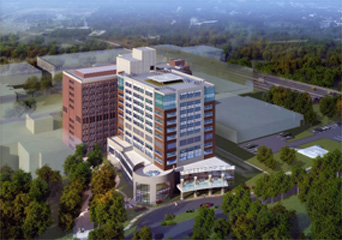 |
|
  |
|
|
MECHANICAL OPTION |
||
Thesis Research:American Concrete Institute. "Building Code Requirements for Structural Concrete (ACI 318-08) and Commentary." 2008. This material code was referenced when redesigning the reinforcing for the concrete slab. Sections and Tables and Charts were utilized to get the correct values for the calculation. ASHRAE. "ASHRAE Fundamentals 2008." ASHRAE, Atlanta. This handbook was referenced throughout this investigation to determine values, check values, and check methods of certain calculations. Avery, G. "Improving the Efficiency of Chilled Water Plants." ASHRAE Journal. (May 2001): 14-18. This article discusses the options for chilled water plant optimization and increasing the efficiency of the plant as a whole. It discusses the various styles of pumping and pros and cons for each. This source provides more information on improving plant design that was useful when designing the chilled water plant. General Services Agency. "Federal Greenhouse Gas Accounting and Reporting Guidance." Technical Support Document. October 6, 2010. This document discusses approaches of estimating the emission rates for purchased chilled water. Emissions of chilled water are related to the electricity required to power the chillers, this document gives default values to use when converting back to the electricity consumed by the chillers in a district plant based on the amount purchased. Lawrence, T. M. "Predicting Condensate Collection from HVAC Air Handling Units." ASHRAE Transactions. Volume 116, Part 2. This article provides a method for estimating the condensate that can be recovered from a cooling coil by implementing psychrometrics. It was useful in determining the amount that is recovered in a year for use in the condensate recovery system design. McQuinston, Parker, Spitler. "Heating, Ventilating, and Air Conditioning: Analysis and Design." Wiley and Sons, Inc. 2005. This book provided useful information when sizing pipe work for the central plant design to utilize in the sizing of the pumps and the other equipment. It also served as a reference for the condensate recovery properties when needed. National Fire Protection Association. "National Electrical Code Handbook 2008." This handbook was consulted throughout the sizing calculations for the new feeders, breakers and conduit. This also helped provide information on the new switchboard and panelboard sizing. National Institute of Standards and Testing. "Energy Price Indices and Discount Factors for Life-Cycle Cost Analysis: 2011." Supplement. September 2011. This supplement was referenced for all of the life-cycle cost analysis. The discount rate and escalation factors provided in this document were utilized and helped more accurately calculate the life-cycle cost of the design alternatives. National Renewable Energy Laboratory. "Source Energy and Emission Factors for Energy Use in Buildings." NREL Technical Report. June 2007. This document was used to determine the emissions for each alternative considered. It provides tables that relate the amount of pollutants to the amount of energy used. Electricity values and Natural Gas values were of interest for this report. Reed Construction Data. "R.S. Means Electrical Cost Data 2009." Klingston, MA. 2009. This reference was used in determining approximate costs for equipment related to the electrical redesign that was necessary for the central plant. Reed Construction Data. "R.S. Means Facilities Cost Data 2011." Klingston, MA. 2011. This reference was used in determining approximate costs for reinforcing related to the structural redesign required from the new central plant being placed on the fifth floor slab. Reed Construction Data. "R.S. Means Mechanical Cost Data 2010." Klingston, MA. 2010. This reference was used in determining approximate costs for equipment related to the mechanical redesign alternatives for use in the life-cycle comparisons. Rishel, James B. "Reducing Energy Costs with Condensing Boilers & Heat Recovery Chillers." (March 2007):46-53. This article describes the implementation of a heat recovery chiller to help serve cooling loads in the winter and heating loads in the summer. It also explains the costs associated with the system and the potential energy savings that can occur. Taylor, S. "Primary-Only vs. Primary-Secondary Variable Flow Systems." ASHRAE Journal. (February 2002): 25-29. This article discusses the pros and cons of primary-only chilled water systems. It includes information about first costs, plant space and pump power consumption as well as chiller staging strategies. This will aid in the design of the new chilled water plant pumping arrangement. Trane. TRACE 700. Trane, Inc. Piscataway, NJ. TRACE was essential in determine energy consumption for the loads calculated for the South Patient Tower. It provided useful comparisons of the various plants while also helping provide the information for the iterative calculation involved with sizing the heat recovery chiller. U.S. Energy Information Administration. "Commercial Buildings Energy Consumption Survey: 2003." Technical Report. 2003. This survey was referenced for finding typical costs of purchased utilities. The report provided collected data from commercial buildings across the country and summarized costs and energy consumption. Wilson, A. "Alternative Water Sources: Supply-Side Solutions for Green Buildings." Environmental Building News. (May 2008). This article describes the various recollection methods of storm water, gray water, and condensate and methods of reuse while maintaining quality required in codes and standards. There is a large discussion on the reuse of air-handler cooling coil condensate in cooling towers due to the high quality of the water and low pollutants. This article helped in the investigation of condensate recovery.
|
||||
| Senior Thesis | Penn State Home | Architectural Engineering | AE Computer Website | Contact |
|
Last Updated:
3/1/12
by Michael Morder Website is hosted by the AE Department ©2011/2012 |
|||